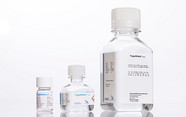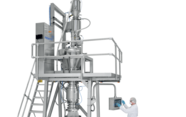The Multifaceted Future of Pharma – Chapter 5: Betting on Biopharma and Better Bioprocessing

Automation, conjugation, and collaboration have all contributed to the augmentation of biopharmaceutical manufacturing in the ten years since the launch of The Medicine Maker. But what factors will drive change and propel innovation over the next ten years? We asked a range of experts from the sector.
We asked: What has/have been the key disruptor(s) driving the industry over the past ten years, and how will this change in the next 10 years?

The March of the mAbs – with Sebastian Arana, Head of Process Solutions, Merck:
“The key disruption in the pharma industry has been the rise of biologics and their increasing relevance compared to small molecules. The first generation were protein-based therapies like monoclonal antibodies, which have demonstrated their therapeutic potential in a variety (and growing list) of indications – from oncology to immunology and several rare diseases.
“This wave created a variety of blockbuster molecules and gave rise to the bioprocessing industry, as therapeutic manufacturers were in need of purpose-built products to effectively manufacture these therapies. In particular, the emergence of single use as a technology fundamentally changed the manufacturing paradigm. The next wave of innovation created cell and gene therapies in the 2010s. During COVID, mRNA, another new modality, demonstrated its potential in the rapid design and production of vaccines.
“Over the next 10 years, we will see this trend to continue, rooted in deep pipeline funnels and sustained R&D spend and funding. mAbs will maintain the lion’s share of the Biologics market, but a variety of novel modalities will continue to grow, effectively complementing the treatment options for patients. From a manufacturing perspective, two trends will likely continue: (i) increasing adoption of intensified processing for a more robust, cost-effective way of producing mAbs without compromising on quality, and (ii) the establishment of new manufacturing templates that are needed to make novel modalities, like viral gene therapies, more broadly accessible.”

Better Vectors – with David Kirn, CEO and Co-Founder, 4DMT
“The biopharmaceutical industry has been shaped by several key disruptors, particularly in the field of genetic medicine. While adeno-associated virus (AAV) vectors have brought genetic medicines to patients with rare and often fatal diseases, the challenges associated with the in vivo delivery of genetic medicine technologies have left many without safe and effective treatment options. Major challenges of AVVs include the need for high doses, expensive manufacturing, and the potential for adverse side effects – such as liver toxicity. Additionally, pre-existing antibodies to conventional vectors limit the utility of these therapies.
“The field needs vectors that are more efficient at transducing specific cell types, and vectors that are more efficiently delivered at low and safe doses by routine routes of administration clinically; simply, we need better vectors. I foresee a shift in the introduction and development of next-generation AAVs using synthetic biology and novel capsids to overcome the limitations of conventional AAVs across the next ten years. One widely recognized approach that could bring superior AAV vectors is directed evolution, which allows humans to create novel bespoke biologics. In the case of AAV, the capsid can be diversified in order to generate billions of potential synthetic AAV capsids. In vivo iterative selection can then be used to identify the synthetic AAV capsid with the best match to the investigator’s target vector profile.
“Though past successes focused predominantly on rare diseases, the industry's gaze now appears set on larger, more complex conditions. As such, we might also expect to see breakthroughs in delivery systems, as enhancements in vector design, transgenes, and immunomodulatory regimens will likely improve delivery efficiency and gene expression, and reduce immunogenicity.”



















